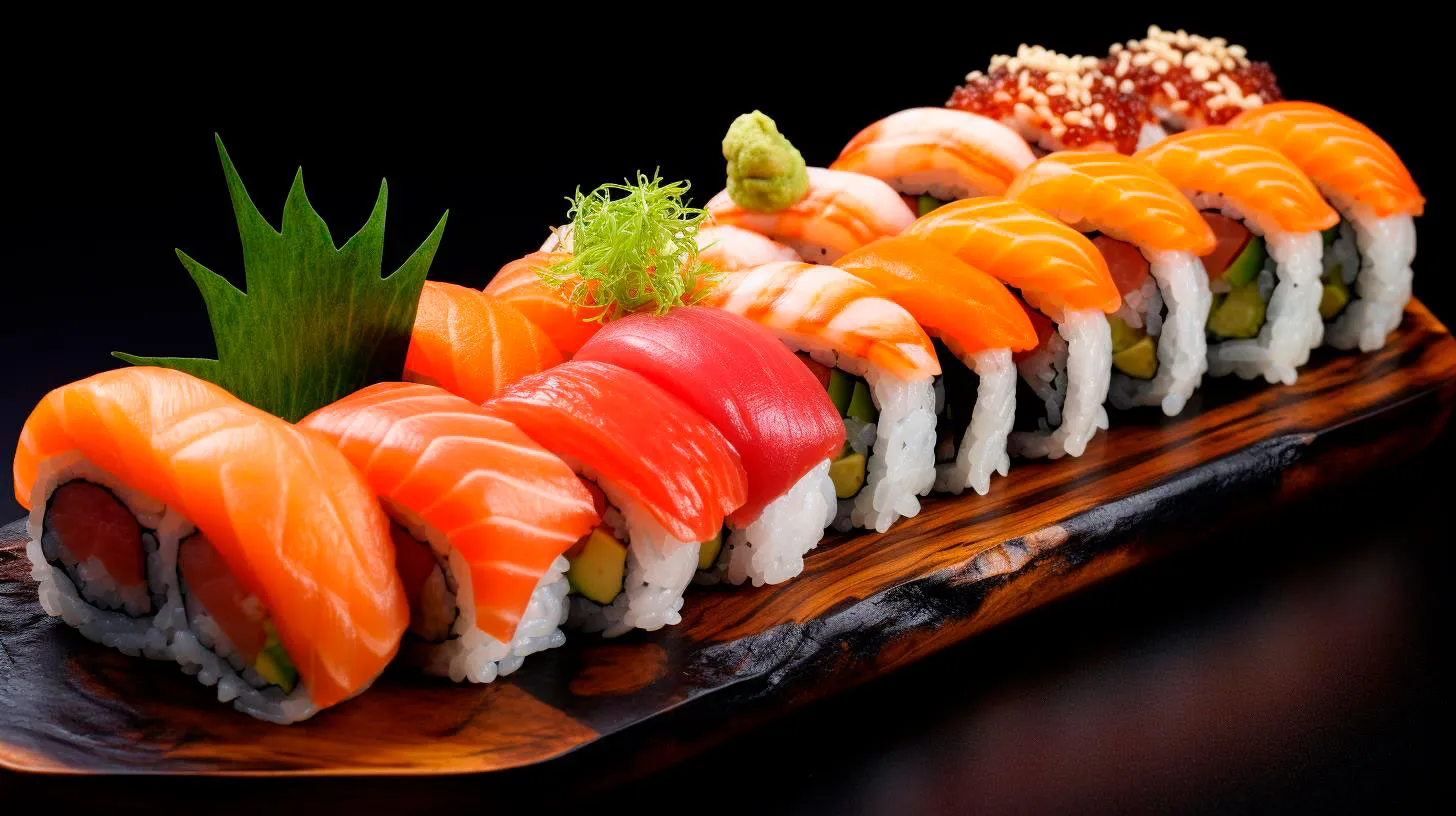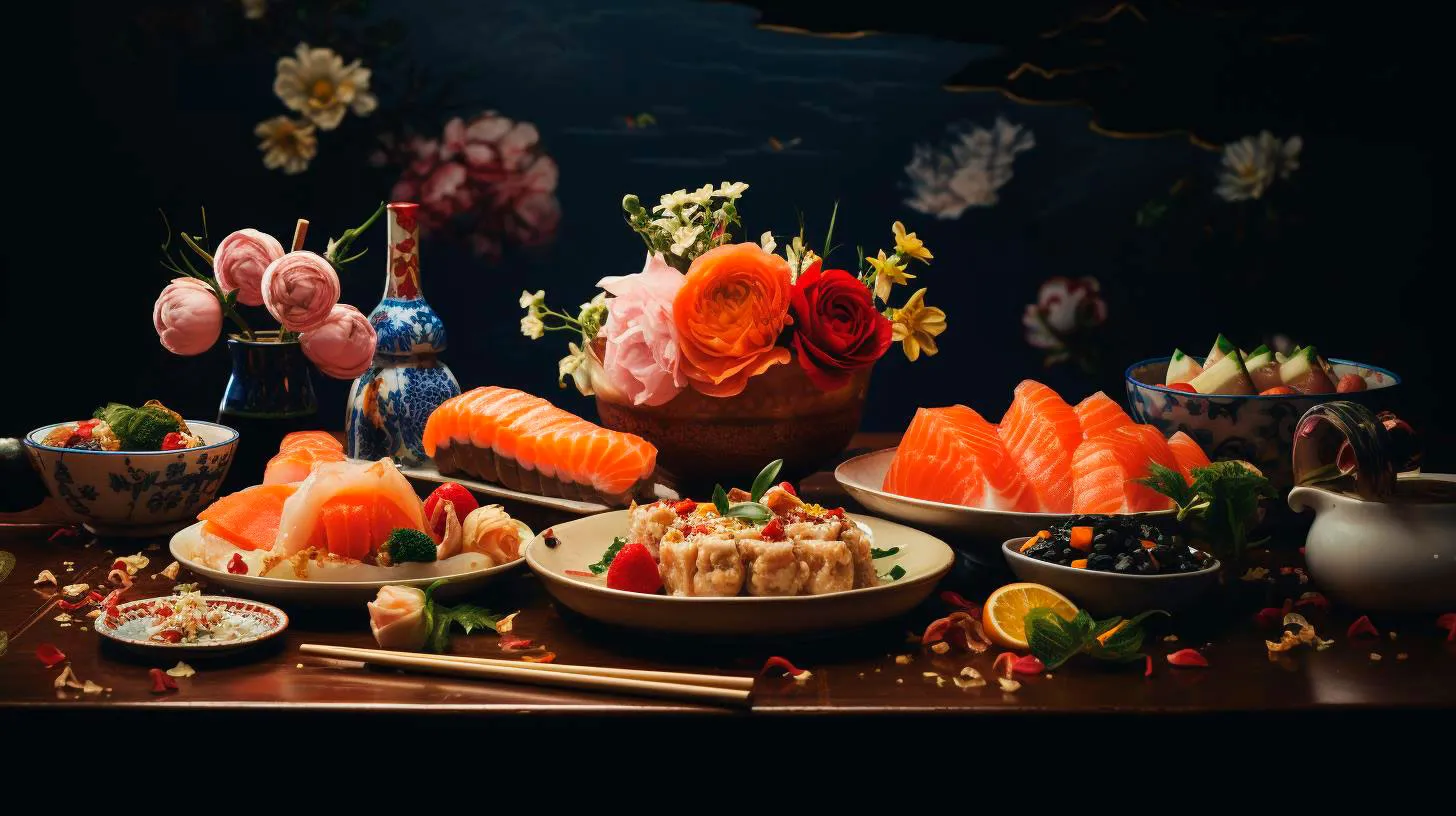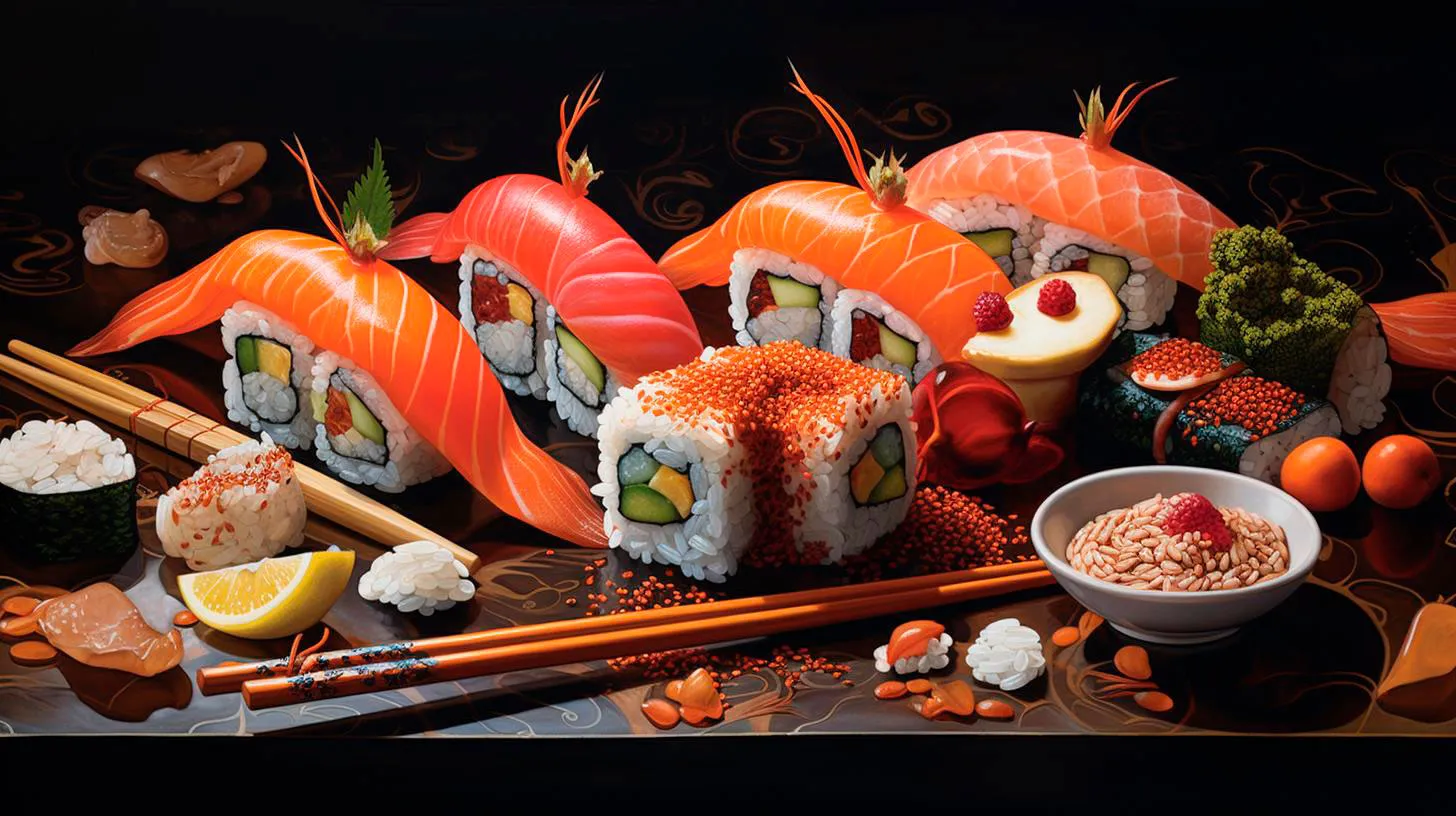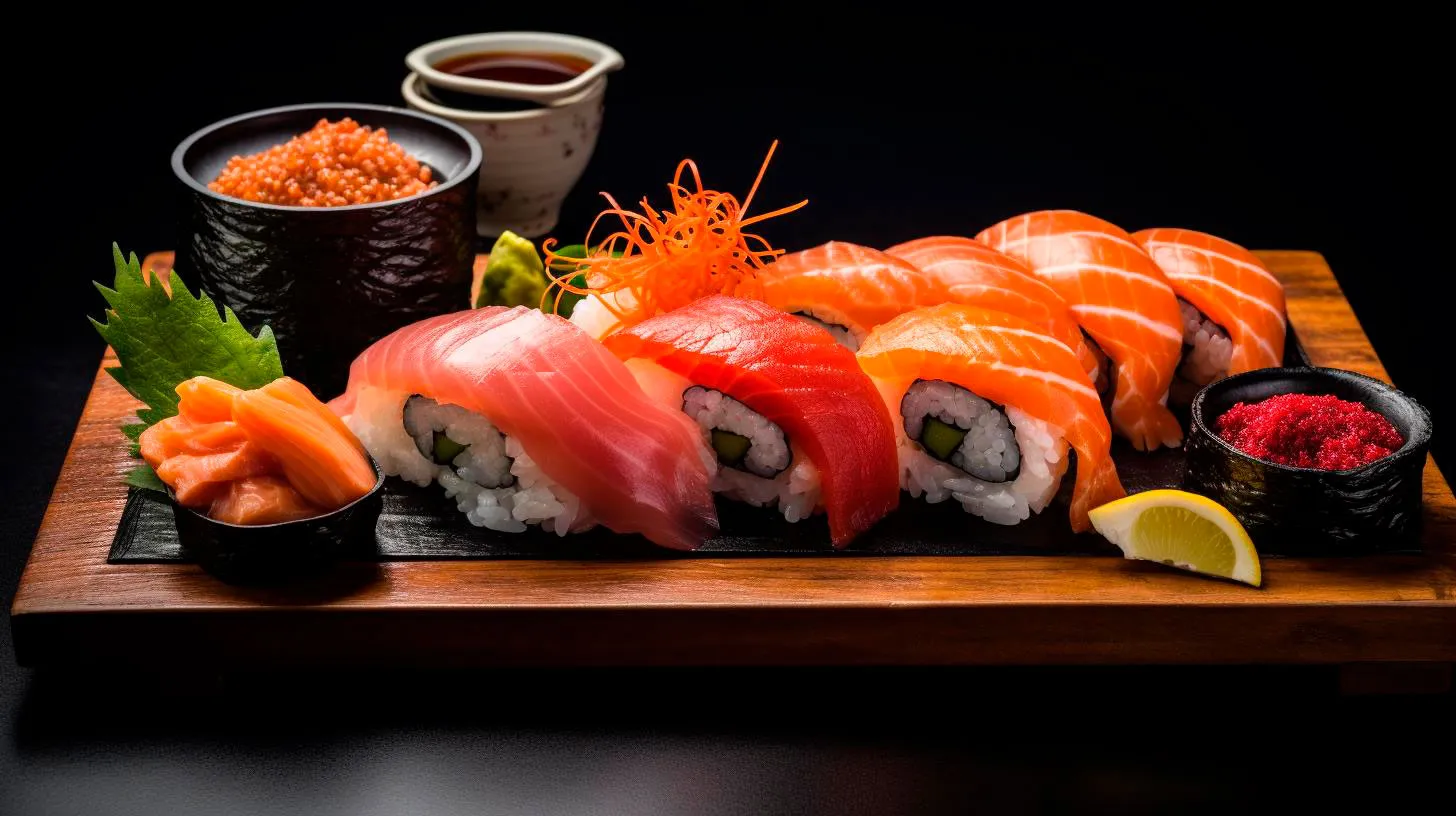The Origins of Sushi: Unveiling a Centuries-Old Gastronomic Tradition
In this article, we will take a deep dive into the origins of sushi, shedding light on its evolution and cultural significance.
The Birth of Sushi
The story of sushi begins in ancient Japan, where fishermen would preserve fish by storing it in fermented rice. This technique, known as “nare-zushi,” was primarily used as a means of food preservation, allowing fish to be stored for several months or even longer. Over time, people discovered that the rice-infused fish had a unique and delectable taste, leading to the birth of sushi as we know it today.
Key takeaway: Sushi originated as a preservation method for fish and evolved into a delectable culinary delight.
Evolution of Sushi
As sushi gained popularity in Japan, new methods of preparation emerged. In the 17th century, a street food version called “Edo-mae sushi” became prevalent in Tokyo. This style involved using vinegared rice and topping it with various ingredients like fish, seafood, and vegetables. Edo-mae sushi was served quickly and enjoyed on the spot, highlighting its convenience and flavors.
During the 19th century, sushi underwent another transformative phase. The renowned sushi chef, Yohei Hanaya, popularized the idea of nigiri sushi, where slices of raw fish were placed on a small mound of vinegared rice. This approach allowed patrons to fully appreciate the taste and texture of the fish, cementing nigiri sushi as a timeless classic.
Key takeaway: From the street food version of Edo-mae sushi to the delicate art of nigiri sushi, sushi continued to evolve, capturing the hearts of food enthusiasts.
Sushi Goes Global
In the early 20th century, sushi began its journey beyond the shores of Japan. As international travel and globalization grew, so did the popularity of this Japanese delicacy. Sushi bars started appearing in major cities around the world, catering to a diverse range of palates.
The invention of refrigeration and air freight further revolutionized the sushi industry. Now, fresh fish and seafood could be transported quickly and efficiently, ensuring that sushi aficionados could enjoy the same quality as those in Japan. This expansion led to the introduction of unique sushi creations like the California Roll, which incorporated local ingredients and catered to the preferences of different cultures.
Key takeaway: Sushi’s global popularity can be attributed to advancements in travel, refrigeration, and the ability to adapt to local tastes.
Cultural Significance of Sushi
Sushi is not merely a dish; it embodies the essence of Japanese culture. The precision and artistry involved in sushi preparation reflect the Japanese value of attention to detail, while the emphasis on fresh and high-quality ingredients reflects their respect for nature.
Sushi also fosters social interactions and communal dining experiences. In Japan, it is customary to sit at the counter of a sushi restaurant and engage in conversation with the chef, who creates each sushi piece right in front of you. This intimate setting allows for a deeper appreciation of the culinary craftsmanship and fosters a sense of connection with the food.
Key takeaway: Sushi not only showcases Japanese artistry but also promotes community and connection through its dining experience.
The Enduring Legacy of Sushi
Today, sushi stands as a testament to the longevity and adaptability of gastronomic traditions. From traditional nigiri sushi to modern fusion creations, sushi continues to captivate food lovers worldwide. Its popularity shows no signs of waning, with numerous sushi restaurants and delivery services catering to the ever-growing demand.
Whether you are savoring a simple salmon roll or indulging in an intricate omakase dining experience, sushi offers a culinary journey that unravels centuries of history and culture.
Key takeaway: Sushi’s enduring legacy speaks to its ability to delight and inspire generations of food enthusiasts around the world.
In conclusion,
Sushi’s origins as a preservation technique have given way to a gastronomic tradition that has traversed time and borders. Its evolution, cultural significance, and enduring appeal make sushi a beloved delicacy loved globally. So, the next time you indulge in a piece of sushi, take a moment to appreciate the rich and flavorful journey that has brought this ancient culinary art to your plate.
Sushi Around the World: Exploring Global Festivals that Celebrate this Delightful Dish
Sushi Festival in Tokyo, Japan
When it comes to sushi festivals, Tokyo, the birthplace of sushi, undoubtedly takes center stage. The city hosts an array of sushi-centered events, attracting both locals and tourists. One such festival is the “Tokyo Sushi Festival,” where renowned sushi chefs showcase their skills and offer visitors a chance to taste an extensive variety of sushi creations. This festival provides a platform for sushi lovers to indulge in the finest sushi dishes while immersing themselves in Japanese culinary traditions.
- Opportunity to sample a wide range of sushi from top sushi chefs
- Learn about the art of sushi making through live demonstrations
- Experience Japanese cultural performances and entertainment
- Discover unique sushi ingredients and innovative sushi creations
Sushi and Seafood Festival in Los Angeles, United States
Los Angeles is known for its diverse culinary scene, and it’s no surprise that the city hosts a vibrant sushi and seafood festival. The “Los Angeles Sushi Festival” brings together a mix of sushi restaurants, seafood vendors, and sushi enthusiasts from all over Southern California. The event offers attendees the opportunity to sample a wide variety of sushi rolls, nigiri, and sashimi, while also exploring different seafood cuisines from around the world.
- Indulge in sushi and seafood tastings from renowned Los Angeles restaurants
- Discover the fusion of flavors and techniques in LA’s sushi scene
- Get inspired by chefs’ creativity through unique sushi presentations
- Engage in interactive workshops and sushi-making classes
Sake and Sushi Festival in Sydney, Australia
Down under in Sydney, sushi enthusiasts gather at the “Sake and Sushi Festival” to enjoy a tantalizing combination of sushi and sake. This festival showcases the perfect harmony between traditional Japanese sushi and the finest Japanese rice wine, sake. Visitors can savor exquisite sushi pairings with a range of sake varieties, while also participating in interactive workshops and tastings.
- Experience the delicate balance of flavors between sushi and sake
- Learn about the rich traditions and brewing techniques of sake
- Discover the versatility of sushi when paired with different types of sake
- Engage with sushi and sake experts through informative seminars
Sushi Street Festival in Sao Paulo, Brazil
Brazil’s vibrant food scene extends to sushi, and the “Sushi Street Festival” in Sao Paulo is a testament to the country’s growing love for this Japanese delicacy. During the festival, numerous sushi vendors line the streets, offering a wide selection of sushi rolls and innovative sushi creations. The event celebrates the fusion of Japanese and Brazilian flavors, creating a unique and exciting culinary experience.
- Explore the Brazilian twist on traditional sushi flavors
- Taste sushi rolls with ingredients indigenous to Brazil
- Witness live sushi-making competitions
- Enjoy live music performances and cultural entertainment
Key Takeaways
Sushi, a dish with humble origins, has transcended borders and gained international popularity. The global festivals celebrating sushi provide an opportunity for people from different cultures to experience the diverse flavors and techniques associated with this delightful cuisine. Whether you find yourself in Tokyo, Los Angeles, Sydney, or Sao Paulo, these festivals offer a unique immersion into the world of sushi, showcasing the talents of renowned sushi chefs and the fusion of culinary traditions. So, if you’re a sushi enthusiast or simply curious about this fascinating dish, make sure to mark your calendars for these captivating sushi festivals around the world!
Sushi-Making Techniques: Discover the Artistry Behind this Japanese Culinary Heritage
1. Sushi Rice: The Foundation of Every Bite
Sushi begins with perfectly cooked rice, seasoned with a unique blend of rice vinegar, salt, and sugar. This special combination enhances the taste and texture of the rice, allowing it to complement the flavors of the accompanying ingredients. The rice should be cooked using traditional methods and cooled to the ideal temperature for shaping.
- Use the appropriate rice-to-water ratio to achieve the desired texture.
- Add the rice vinegar mixture gradually while gently folding to evenly distribute the seasoning.
- Cool the rice quickly to prevent it from becoming mushy.
2. Nigiri: Mastering the Art of Hand-Pressed Sushi
Nigiri is a classic sushi style that showcases the craftsmanship of the sushi chef. It involves pressing a small mound of sushi rice between the fingers and topping it with a carefully sliced piece of seafood, such as tuna, salmon, or shrimp. The balance between the rice and the fish is crucial for achieving the perfect bite.
- Ensure the rice is slightly warm for easy shaping and proper adherence.
- Apply gentle pressure when forming the rice to retain its delicate texture.
- Use the freshest and highest-quality seafood to enhance the flavors of the nigiri.
3. Maki: The Art of Rolling
Maki, or sushi rolls, are created by rolling various ingredients in a sheet of nori (seaweed) using a bamboo mat. The artistry lies in achieving a tight roll with evenly distributed fillings. There are several types of maki, including hosomaki (thin rolls) and futomaki (thick rolls), each offering a unique combination of flavors and textures.
- Spread a thin layer of rice on the nori, leaving a small border for sealing.
- Place the ingredients in a neat row at one end of the nori and roll tightly using the bamboo mat.
- Wet the edge of the nori to seal the roll securely.
4. Tempura: The Perfect Crunch
Tempura adds a delightful crunch to sushi rolls. This deep-fried Japanese cooking technique involves coating ingredients, such as shrimp or vegetables, in a light, crisp batter. The tempura is then carefully incorporated into maki rolls or served as a standalone dish.
- Use ice-cold water to create a light and airy tempura batter.
- Ensure the oil temperature is hot enough to produce a crispy texture without absorbing excess oil.
- Drain tempura on a wire rack to maintain its crunchiness.
5. Sashimi: Artful Simplicity
Sashimi showcases the pure flavors of pristine seafood with minimal adornment. It is thinly sliced and served raw, allowing each piece to demonstrate the quality and freshness of the fish. The knife skills required for sashimi are of paramount importance, as the cuts must be precise to achieve the perfect texture and presentation.
- Use a long, sharp knife to make clean and smooth slices.
- Slice against the grain to accentuate the tenderness of the fish.
- Arrange the sashimi on a beautiful dish, considering color, texture, and presentation.
In conclusion, sushi-making is an intricate art form that requires years of practice and dedication to master. From the meticulous preparation of the rice to the precise cuts of the fish, every step contributes to the overall experience of enjoying sushi. So, the next time you savor a sushi roll or savor a piece of nigiri, remember the artistry and craftsmanship behind this beloved Japanese culinary heritage.
Sushi Fusion: Innovative Variations Reflecting Diverse Cultures and Flavors
Sushi fusion, as it is known, combines traditional Japanese techniques with diverse cultural and culinary influences, resulting in a delightful blend of flavors that cater to different palates. In this article, we will explore some of the most exciting sushi fusion variations that reflect the intersection of different cultures and flavors.
The Rise of Sushi Fusion
Sushi has a rich history dating back to the 8th century in Japan. Traditionally, sushi consists of vinegared rice combined with raw or cooked seafood, often served with soy sauce, wasabi, and pickled ginger. However, as sushi gained popularity globally, chefs started experimenting with local ingredients and flavors, giving rise to the sushi fusion trend.
Sushi fusion embraces a diverse range of cultural influences, including Thai, Mexican, Hawaiian, and even Italian. By incorporating different ingredients, spices, and preparation techniques, sushi fusion creates a whole new dimension of flavors that attract a wider audience.
Exciting Sushi Fusion Variations
1. Mexican-inspired Sushi: Mexican sushi fusion combines the freshness of Japanese sushi with the bold flavors of Mexican cuisine. For example:
- Tempura fish tacos topped with sushi-grade fish and salsa
- Spicy tuna rolls with guacamole and jalapenos
- Tortilla-wrapped sushi rolls with a Mexican twist
2. Hawaiian Poke Sushi: The fusion of Japanese sushi and Hawaiian poke presents a tantalizing combination of flavors from the sea. Some popular variations include:
- Ahi tuna poke bowls served on a bed of sushi rice
- Salmon poke sushi rolls with mango and avocado
- Spicy crab poke with sushi-grade fish on the side
3. Thai Fusion Sushi: Thai-inspired sushi introduces vibrant flavors with a touch of spiciness. Key Thai fusion variations include:
- Green curry shrimp sushi rolls
- Mango and sticky rice sushi with a coconut-infused twist
- Thai basil-infused salmon nigiri
Key Takeaways
1. Sushi fusion combines traditional Japanese techniques with diverse cultural influences.
2. Sushi fusion offers a wide range of vibrant and flavorful variations.
3. Each sushi fusion variation provides a unique and exciting dining experience.
4. Sushi fusion caters to different palates and expands the sushi-eating demographic.
The Future of Sushi Fusion
As sushi fusion continues to gain popularity, culinary creativity knows no bounds. With the world becoming more interconnected, we can expect even more innovative and diverse sushi fusion variations in the future. Chefs are constantly exploring new ways to combine flavors, textures, and ingredients, creating an ever-evolving culinary experience.
With an increasing demand for unique dining experiences, sushi fusion is perfectly positioned to meet the expectations of adventurous food enthusiasts. Its ability to reflect different cultures and flavors while still honoring traditional sushi techniques makes it an exciting and dynamic addition to the culinary landscape.
In conclusion, sushi fusion has revolutionized the way we perceive and enjoy sushi. By incorporating ingredients and techniques from different culinary traditions, sushi fusion delivers an explosion of flavors and textures that appeal to a wider audience. So, the next time you want to embark on a culinary adventure, give sushi fusion a try and discover the delightful variations that reflect diverse cultures and flavors.



